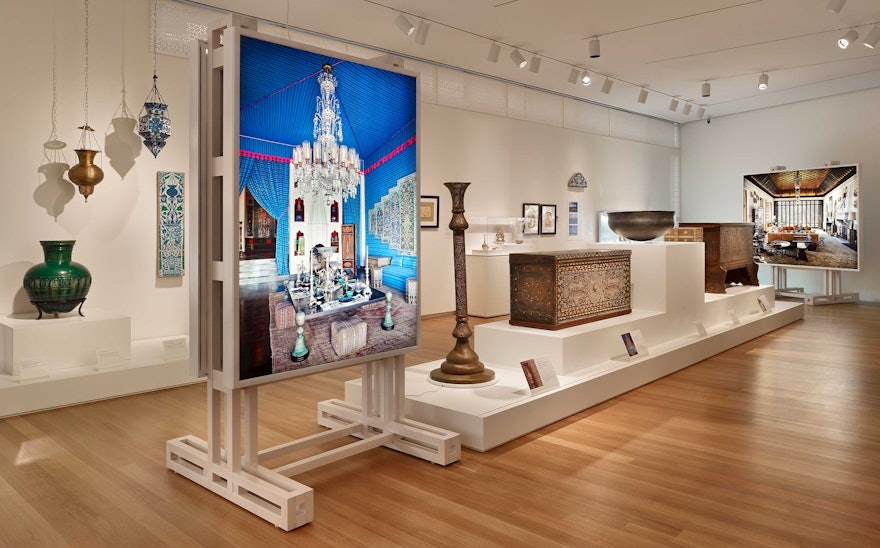Perched on the Pacific Ocean with views of Honolulu’s Diamond Head, Shangri La, the Hawaiian estate of the heiress Doris Duke (1912-1993), is located in an exotic setting. And the home itself is an extraordinary environment, a visionary fantasia that melds a modern sense of form with the tropical landscape and art and decorative elements from throughout the Islamic world. Timed to the centenary of Duke’s birth, Doris Duke's Shangri La: Architecture, Landscape and Islamic Art is a new exhibition at the Museum of Arts and Design in New York that looks at this unique property and its collections. Pentagram has designed the exhibition and accompanying book, Doris Duke’s Shangri La: A House in Paradise.
“Inventive synthesis” is the term the exhibition curators Thomas Mellins and Donald Albrecht have coined to describe Duke’s creation at Shangri La. Built in 1937, the five-acre estate is an interlocking complex of buildings, terraced gardens and pools that incorporates architectural features like carved marble doorways, decorated jali screens, gilt and coffered ceilings, and floral ceramic tiles, along with Islamic art amassed by Duke over the years as she decorated her retreat. Opened to the public since 2002, the complex is now owned and managed by the Doris Duke Foundation for Islamic Art and maintains a diverse collection of 2,500 objects spanning from the first millennium B.C. to the 20th century, from Spain to the Philippines.
The designers worked closely with the Doris Duke Foundation for Islamic Art and the curators to develop an exhibition design that captures the spirit of the house. The Shangri La experience is essentially site specific, and the challenge for the designers was creating a context for the historic collection and interiors in a traveling exhibition that could be adapted to various environments. They created a modular design that displays artifacts on movable easels and tables, including large-scale backlighted photographs of Shangri La that convey the drama and beauty of the location. The noted architectural photographer Tim Street-Porter was commissioned to create new images of the house and grounds.
Duke referred to Shangri La as “Spanish-Moorish-Persian-Indian complex,” and the house and collection pull together a variety of strands to create a unique whole, a collage of parts that work together. Designed by the architect Marion Sims Wyeth in the Bauhaus-influenced modernism of the period, the white, cubic structure of Shangri La sets off the extravagant ornament of the décor and is an intrinsic element of the unusual setting. The abstract patterns of the art and furnishings—the carved marble jali screens, the ceramic tile panels—are visually linked to the geometric shapes of the architecture, and the home becomes its own kind of living, breathing organism of design. The modernist structure inspired the hard white geometry of the exhibition design, which similarly offers a framework that emphasizes the complex and colorful patterns and forms of the exhibited works.
Designed to travel, the exhibition is presented on large mobile fixtures—easels and drafting tables—that can easily be configured for various gallery layouts. The easels hold large-scale backlighted photographs—some as large as 8 feet wide by 6 feet high—of key rooms and views of Shangri La. Artifacts are displayed alongside smaller photographs showing the pieces in situ at the house. The exhibition design establishes an environment that does not try to recreate the interiors of the house, but gives a sense of their grand scale. The use of easels, drafting tables and lightboxes creates the context of a studio, suggesting the careful thought and planning that went into the development of Shangri La and its collections. For the MAD installation, the designers have also installed perforated jali-like panels in the gallery windows, temporarily returning a Moorish motif to Edward Durell Stone’s original design for 2 Columbus Circle.
The exhibition also features contemporary works by 6 former artists in residence at Shangri La, including Afruz Amighi’s “Rocket Gods,” hanging forms that resemble lamps or missiles; calligraphic drawings by Mohamed Zakariya; and photographs of digital projections by Shahzia Sikander.

